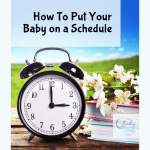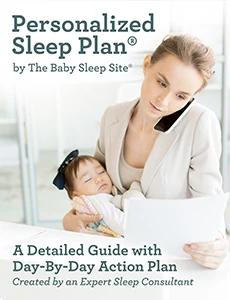
If you’re a parent who thinks a lot about your baby’s sleep (and if you’re a Baby Sleep Site reader, you probably are), then you know that having a predictable, consistent schedule in place can go a long way toward helping your baby establish good sleep patterns. In fact, our sample baby schedules are some of the most popular articles on the site. Clearly, parents are interested in establishing routines!
For some of us, though, a consistent schedule for baby can lead to the onset of serious cabin fever for mom or dad! That consistent schedule can contain two or three (or even four or five!) naps, which can make it impossible to get out of the house during the day. Being housebound might work for some parents, but for others, being “trapped” at home can be maddening. Whether you and your baby are introverts or extroverts will make a big difference!
So what’s a “get out and go” mom (or dad) to do? We get this question quite a bit here at The Baby Sleep Site — moms want to teach their babies healthy sleep habits, but they don’t want to be confined by a rigid schedule. “Can I teach my baby to sleep when I’m on the go?” these moms ask. This article will attempt to answer that question.
What Do You Mean By “Baby Sleep On the Go”?
If your schedule (and by extension, your baby’s) is fairly consistent from day to day, and you only have one or two interruptions to that schedule each week, you’ll likely have few issues when it comes to getting your baby to sleep well. Most babies (although not all!) can handle a few variations in the routine. But if you’re out of the house constantly, and your days look nothing alike, it can be hard to get your baby sleeping well.
Can I Sleep Train On the Go?
Here’s the short answer: probably not. It’s not impossible, but it is very difficult. Remember that falling asleep and staying asleep, without any sleep “props” or associations, is a skill babies have to learn. And, when you provide your baby with predictable, consistent routines each day, you give him lots of opportunities to practice this new skill.
Of course, there are occasional exceptions to this rule. You may have a highly adaptable baby who’s able to nap at different times each day, who can sleep anywhere, through anything, and whose bedtime can shift by as many as two or three hours without it making much impact. If you do, congratulations! If you don’t, read on!
There are two factors that make sleeping on the go hard for a baby: baby’s temperament and baby’s nap needs.
Baby’s Temperament Can Make It Hard to Sleep Train On the Go
Nicole defines temperament as how your baby reacts to situations and stimuli, as well as your baby’s mood, ability to calm himself, and level of activity. Some babies are highly adaptable, or are naturally relaxed and easy-going. These babies may do well with sleep training on the go. But if you have a slow-to-adapt baby, developing a consistent and predictable routine will be a key part of teaching your baby how to sleep well. As Nicole says, “Slow to adapt children crave routine and need to know what to expect next.” In general, we recommend you plan to stay put for at least two weeks for official “sleep training.”
Baby’s Nap Needs Can Make It Hard to Sleep Train On the Go
Babies and toddlers need naps. How many naps and how often depend on a baby’s age. Younger babies need multiple naps each day. As they grow, babies gradually narrow down to three naps each day, then two and (maybe) one. Keep in mind that naps are NOT a “bonus” — naps are necessary! Nicole supports Weissbluth’s philosophy that “sleep begets sleep.” Therefore, getting plenty of rest during the day is essential in order for a baby to sleep well at night. You may be tempted to think that as long as your baby is getting enough sleep at night, her naps aren’t important. This usually isn’t the case. The vast majority of babies need naps during the day in order to achieve balanced sleep.
Also, keep in mind that “moving” sleep (i.e. sleep that happens in a car seat or a stroller) isn’t as restorative as sleep occurring in a crib or bassinet. This makes sense when you consider your own sleep experiences. Do you sleep better sitting up in a moving car or lying down in your bed? The same is true for your baby. Light and noise during naps are factors to consider as well. Your child will sleep better in a darkened, quiet room than in a brightly lit, noisy one.
However, this isn’t true for every child. In the United States, many of us associate naps with baby sleeping in a crib, in a darkened, quiet room. In other parts of the world, however, naptime looks different! After reading this article, Pia, a Baby Sleep Site reader from Finland, wrote this:
“Here in Finland and in Sweden it is very common that we, for the daytime naps, put our babies to sleep outside in their strollers or baby carriages. I know this probably sounds alien to you, but the truth is that they sleep much better outside in the fresh air. Of course we put lots of clothes on them, and the stroller is placed next to a window so we can keep an eye on them at all times.”
Pia went on to write,
“This facilitates sleeping on the go. Many times, I have taken my daughter for lunch to a café, fed her, changed her, dressed her and put her outside the café window for a nap, whilst I have been able to enjoy a coffee and a magazine on the inside, watching her constantly.”
As a result of this outdoor approach to naps, Pia says,
“Our daughter is able to sleep anywhere, and we are not bound to staying at home.”
International differences like these might provide you with a different perspective on naps. In general, we’ve found that babies sleep best in darkened, quiet rooms, but stories like Pia’s are a good reminder that cultural differences and norms can produce different sleep results for different babies!
Our Recommendation: When Sleep Training, Stick Close to Home!
When you’re learning to do something new, you need to spend time and energy developing your new skill. Apply this same mentality to your baby’s sleep training. Some kids will pick up these new skills quickly. For others, though, it’ll take a while. Accept your child’s temperament and prepare to be patient. It’s all part of being a parent! Remember too that the days of being tied to home are short-lived. Your baby won’t always be napping every two hours! By 18 months, most babies are napping just once a day (and some transition to one nap before that.) Once there are fewer naps happening during daylight hours, it’s much easier to get out and about.
But What If Sticking Close to Home Just Isn’t An Option?
If you don’t have to be on the go with your baby, then we here at the Baby Sleep Site recommend prioritizing your baby’s needs over your own and staying home to sleep train your baby. We know, however, that for some of you, being on the go isn’t optional (whether it’s because your personality needs it for sanity or because you have things you need to get done).
If this is the case for you, there are a few things you can do to encourage optimal sleep for your baby while the two of you are on the go:
- Build in as much consistency as you can. Consider keeping a log of your daily activities for a week or two, and then look for patterns that could help you build some predictability into your routine.
- Add some on-the-go products to your arsenal. Snoozeshade sells a variety of items that can make it easier for babies to sleep while they’re out and about with mom, including car seats, strollers, and even Pack-n-Play covers. You will also want to consider a portable white noise machine such as the Yogasleep or Hatch.
- Monitor how much sleep your baby is getting. Determine how much sleep your baby needs based on her age. Then make it a priority to see that she gets it. In addition, watch for signs that your child isn’t getting enough sleep. If your baby shows any of these signs, make whatever changes you can to your schedule to help her get more rest. If you have a choice, attempt to have at least the first nap of the day at home as that is most often the most important.
Everyone’s family is unique. While you may see other babies sleeping in a stroller as their parents stroll through the mall, remember that we don’t want our babies “crashing” from exhaustion, but rather learning healthy sleep habits. While the occasional stroller or car nap is just fine, we don’t recommend that be your daily routine. After all, gas is expensive and even walking the mall will get boring after the 300th day in a row.








